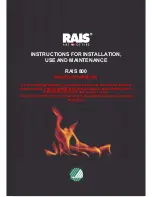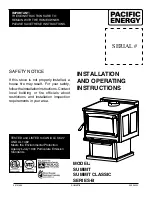
3.8 TERMINAISON HORIZONTALE
16.10A
Confi guration d’évacuation simple
(un coude de 90° seulement).
COURSE
VERTICALE
REQUISE EN
PIEDS
(MÈTRES)
V
T
LONGUEUR DES COURSES HORIZONTALES PLUS
LES DÉVIATIONS EN PIEDS (MÈTRES)
H
T
90°
90°
90°
V
1
V
2
H
1
H
2
0
2,5
(0,8)
5
(1,5)
7,5
(2,3)
10
(3,1)
12,5
(3,8)
15
(5,6)
40 (12,2)
10 (3,1)
20 (6,1)
30 (9,1)
17,5
(5,3)
20
(6,1)
39 (11,9)
(H
T
) < (V
T
)
Lorsque la confi guration de l’évacuation exige plus d’un coude de 90°, les formules suivantes
s’appliquent :
Formule 1: H
T
< V
T
Formule 2: H
T
+ V
T
< 40 pieds (12,2m)
Exemple :
V
1
= 3 PI (0,9m)
V
2
= 8 PI (2,4m)
V
T
=
V
1
+
V
2
= 3 PI (0,9m) + 8 PI (2,4m) = 11 PI (3,4m)
H
1
= 2,5 PI (0,8m)
H
2
= 2 PI (0,6m)
H
R
=
H
1
+
H
2
= 2,5 PI (0,8m) + 2 PI (0,6m) = 4,5 PI (1,4m)
H
O
= 0,03 (trois coudes 90° - 90°) = 0,03 (270° - 90°) = 5,4 PI (1,7m)
H
T
=
H
R
+
H
O
= 4,5 PI (1,4m) + 5,4 PI (1,7m) = 9.9 PI (3m)
H
T
+
V
T
= 9,9 PI (3m) + 11 PI (3,4m) = 20,9 PI (6,4m)
Formule 1:
H
T
< V
T
9,9 PI (3m)
<
11 PI (3,4m)
Formule 2:
H
T
+ V
T
< 40 PI (12,2m)
20,9 PI (6,4m) < 40 PI (12,2m)
Puisque les deux formules sont respectées, cette confi guration d’évacuation est acceptable.
Consultez le graphique pour déterminer la
course verticale nécessaire V
T
par rapport à la
course horizontale requise H
T
.
La section ombragée à l’intérieur des lignes
représente des valeurs acceptables pour
H
T
et
V
T
COURSE
VERTICALE
REQUISE EN
PIEDS
(MÈTRES)
V
T
LONGUEUR DES COURSES HORIZONTALES PLUS
LES DÉVIATIONS EN PIEDS (MÈTRES)
H
T
90°
90°
90°
V
1
V
2
H
1
H
2
0
2,5
(0,8)
5
(1,5)
7,5
(2,3)
10
(3,1)
12,5
(3,8)
15
(5,6)
40 (12,2)
10 (3,1)
20 (6,1)
30 (9,1)
17,5
(5,3)
20
(6,1)
39 (11,9)
COURSE
VERTICALE
REQUISE EN
PIEDS
(MÈTRES)
V
T
LONGUEUR DES COURSES HORIZONTALES PLUS
LES DÉVIATIONS EN PIEDS (MÈTRES)
H
T
90°
90°
90°
V
1
V
2
H
1
H
2
0
2,5
(0,8)
5
(1,5)
7,5
(2,3)
10
(3,1)
12,5
(3,8)
15
(5,6)
40 (12,2)
10 (3,1)
20 (6,1)
30 (9,1)
17,5
(5,3)
20
(6,1)
39 (11,9)
65
W415-1427 / 09.27.17
FR
















































